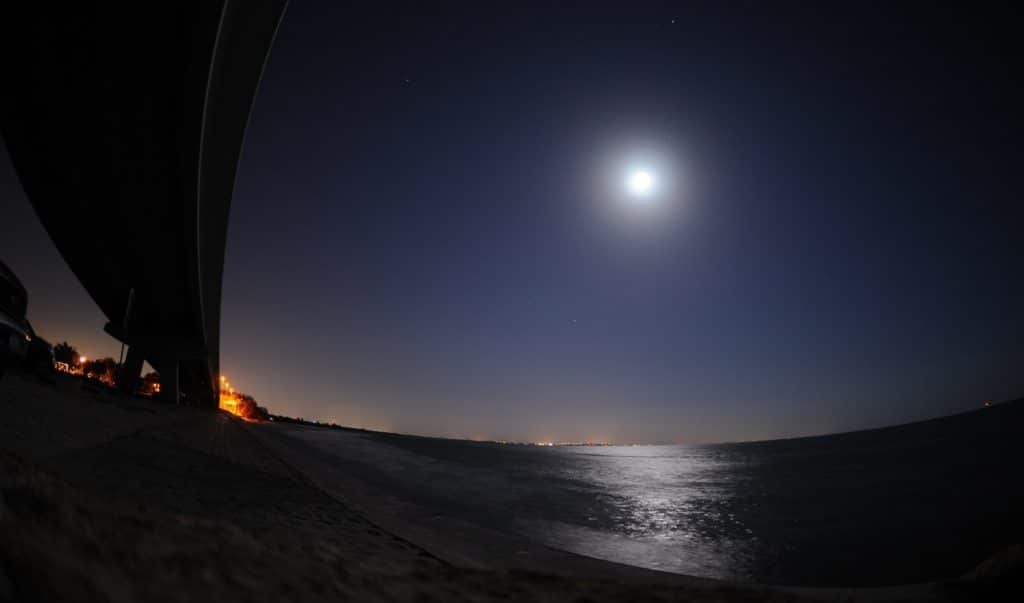
I pedaled along slowly in my Hobie Pro Angler kayak, the ripples lapping against the hull. The tide was starting to run in the Caloosahatchee River near Fort Myers, and as the partial cloud cover broke, I could see the moon rising above the horizon.
Approaching the bridge I intended to fish, I could already see tarpon breaking the surface. These weren’t small fish; most were good-size adults in the 6- to 7-foot range, many over 100 pounds and some better than 200.

I heard the violent explosions of feeding tarpon around me, loud enough to startle even the saltiest angler. At this point I pedaled into the current to position myself for first casts, enthralled by the amazing sounds of tarpon busting bait.
My first cast, with a 1-ounce lead head and 10-inch black Hogy Jigging Eel, landed 20 feet ahead of a nearby feeding boil. I let the lure sink for several seconds to fall midway into the water column, about 6 feet below the surface. Then I flipped the spinning reel’s bail by hand. The sensitive braided line offered a direct connection, allowing me to sense every wiggle of my jig. After each twitch of the rod tip, the bait darted and swirled on the drop.
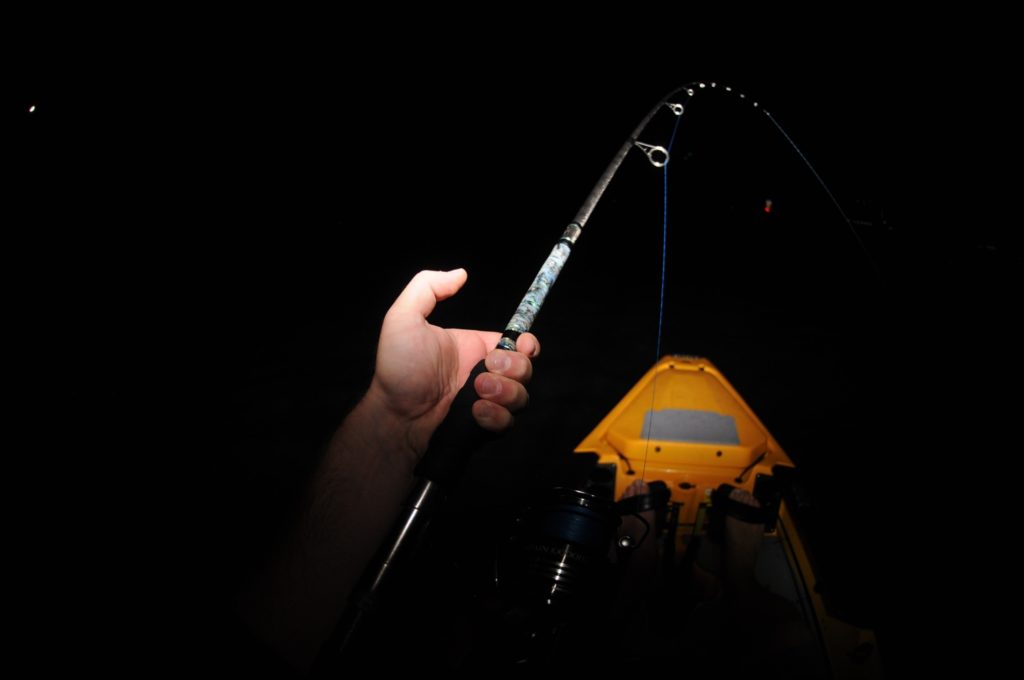
I tensed my arms in anticipation after each jerk of the rod, and soon enough, the rod tip bowed deeply toward the water. I reared back on the rod, letting the spine of the 8-foot stick absorb the shock of the strike, driving the jig head into the tarpon’s jaw.
I kept the drag tight, allowing the hook point to fully penetrate. Line began peeling off, and in seconds the big fish had taken 30 yards of line and erupted from the surface.

With the moon shining brightly now, I could see that the tarpon would go well over 6 feet in length. I thrust my arms forward in the classic bow-to-the-king gesture as the fish thrashed its head side to side before returning to the water with an enormous splash.
Suddenly the line slackened momentarily, and then the rod bent violently in the opposite direction. As the tarpon leaped again, I struggled to get the rod in position. I managed to turn the kayak and pedaled toward the fish. Then it took off in a series of jumps across the surface.
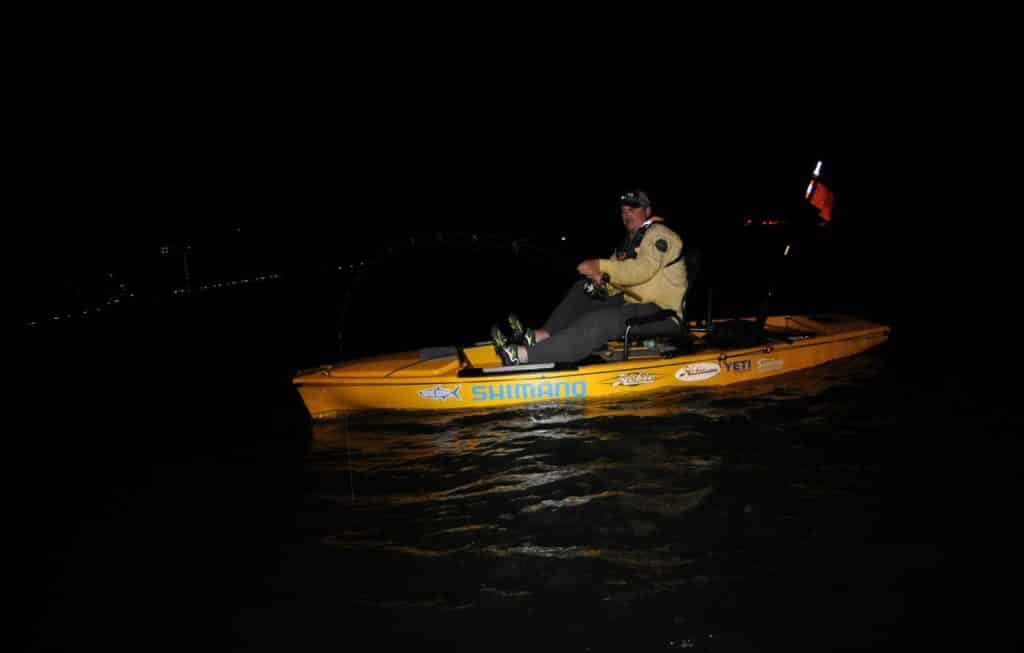
Early on in the fight, things were already getting down and dirty. The tarpon began to go deep, pulling hard toward the floor of the bay and towing me right behind it. As it pulled, I adjusted my rudder to hold a 30-degree angle against the fish, maximizing resistance in hopes of wearing it down.
This tug of war continued for some time. The big fish came to the surface, taking in a large gulp of air. The rod was bent well into the butt as I lightly palmed the spool to increase drag. At this point the tarpon was towing me at a good 2 knots against the outgoing tide.
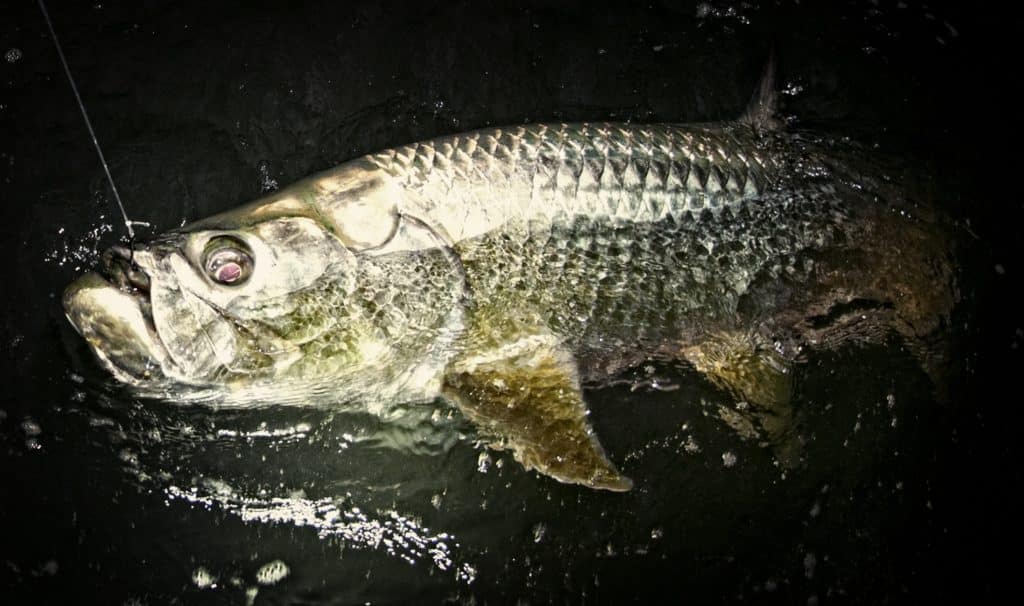
After another gulp of air, the fish tired and stayed near the surface. I finally managed to pull it alongside the kayak, admiring its beauty beneath the glow of my headlamp — the thick body covered in baseball-size scales, a beautiful iridescent blue-green over the silver. Its huge eyes were black and depthless.
Carefully, I managed to remove the hook (see “The End Game,” below). Then, with a single kick, the big tarpon threw gallons of water over me, and it was gone.
That memorable catch came on a spring evening as tarpon cruised in and out of the bridge shadows, feeding on huge concentrations of small threadfin herring.
THE EXPERIENCE IS ONE THAT MOST INSHORE ANGLERS AROUND THE WORLD DREAM ABOUT — STALKING BIG TARPON, FINE-TUNING YOUR PRESENTATION, AND HOOKING AND LANDING THE MOST REVERED AND ACROBATIC OF INSHORE GAME FISH.

Fortunately, Southwest Florida holds an abundant population of tarpon year-round. Most nights from March through October, die-hard anglers willing to put in the time and effort can observe a feeding frenzy in these waters.
During these months, for a few hours after the sun has sunk below the horizon, a magical event unfolds with the turn of the tide. Nocturnal outgoing tides offer a bounty of forage for staging tarpon. Large flushes of crabs, shrimp and glass minnows make for easy pickings.

During late May and into early July, populations of pilchard fry are at their peak. Nightly feeding frenzies during this time can be both exciting and frustrating (when they’re reluctant to bite). You might hear hundreds of tarpon ripping through bait schools, sometimes so loudly and so suddenly that it sounds like cinder blocks are being dropped from the bridge.
FISHING UNDER THE COVER OF DARKNESS, WHETHER IN A KAYAK OR SKIFF, IS CERTAINLY ONE OF THE MOST PRODUCTIVE TIMES TO TARGET TARPON. IN PRESSURED FISHERIES, TARPON THAT REMAINED TIGHT-LIPPED AND CAUTIOUS DURING THE DAY BEGIN AGGRESSIVELY FEEDING ON PREY TRAPPED IN THE EVENING’S TIDAL FLOW.
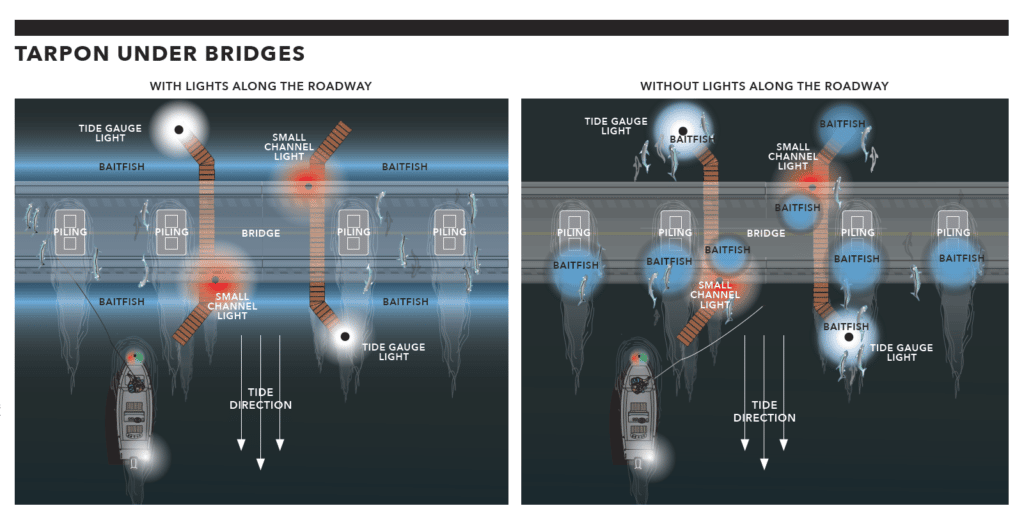
Short tidal windows of ideal current and bait movement often lead to quick yet spectacular periods of fishing. Intrepid tarpon hunters will wait in the darkness for hours in anticipation of such events.
The first 90 minutes after a high slack tide will push the largest quantities of baitfish past prime feeding areas. Planning your trip around this tidal change can maximize your tarpon catch.

The most productive months for tarpon fishing coincide with the hottest daytime temperatures Florida has to offer. Sweltering heat gives rise to intense afternoon thunderstorms that eventually cool off the evening air.
Beyond the productive fishing after hours, heading out under the cover of darkness also offers physical comfort and solitude. Evening temps often hang comfortably in the mid-70s. Boat traffic and angling pressure are often minimal or nonexistent, offering unhindered mobility and angling.
While the sunset bite during early summer months — when migratory tarpon populations are peaking — can be very productive, the hour just after dark can be pretty quiet. During this time, predatory fish like the tarpon need some time to allow their eyes to adjust to the change in ambient light. This is a transition period for the pods of tarpon, which feed by day along nearby beaches, passes and flats, to move in and congregate around the bridges for their nocturnal feeding.
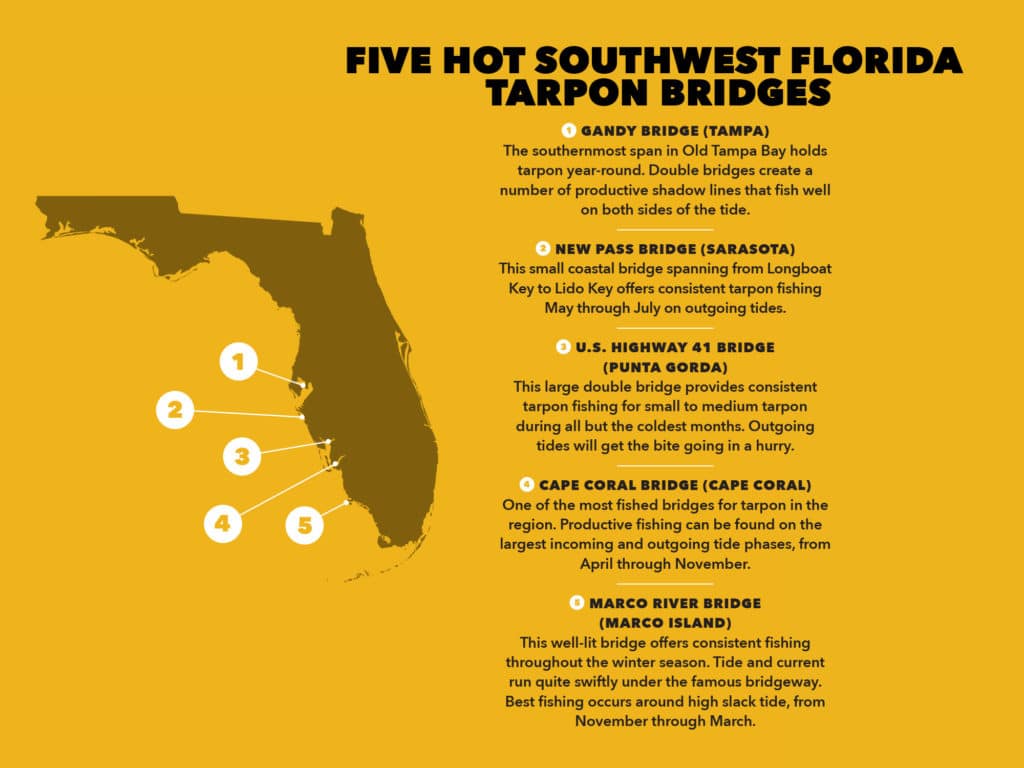
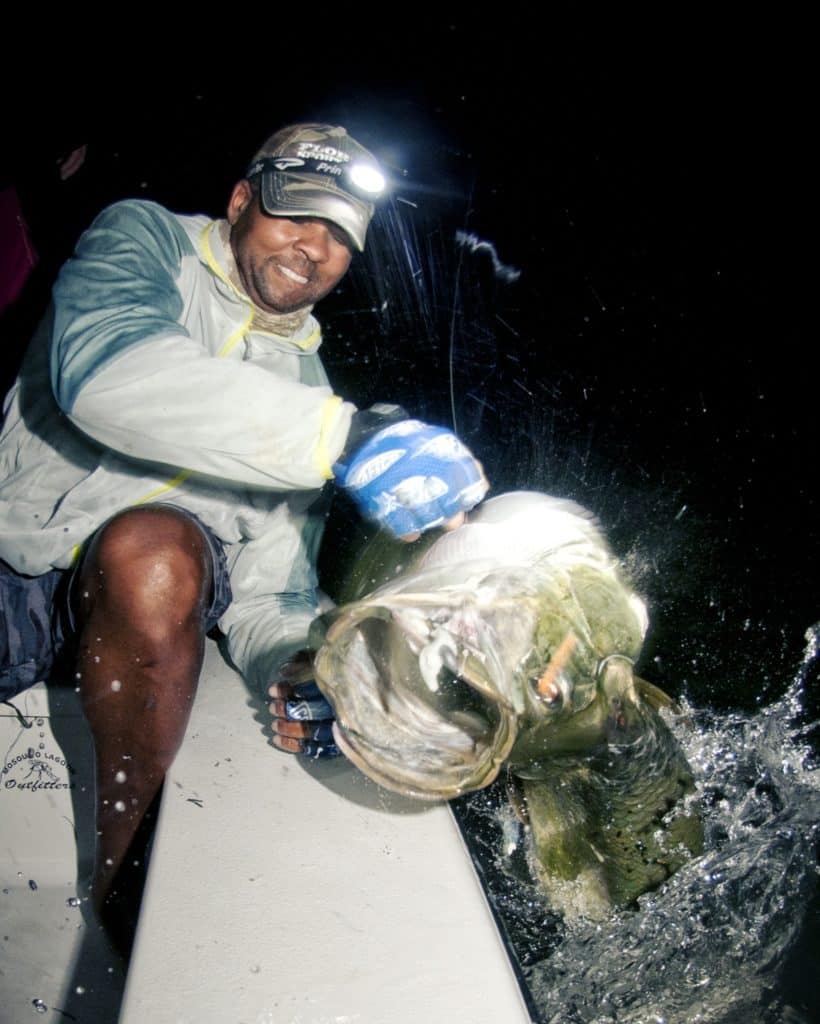
There are two schools of thought when choosing an artificial lure for tarpon. The first imitates local forage with a lure of similar size, shape and color. This approach is no doubt very effective, and many lure manufacturers strive to create lures that imitate specific baits down to the finest details.
But what do you do when the average available forage is less than 2 inches long — when tarpon are gorging on those massive schools of fry pilchards and sardines? Fly anglers can match that hatch, though fly-fishing bridges can be tough. But imitating these small baits with lures that you can cast on spinning or conventional tackle can be nearly impossible.

During these times of massive bait hatches, I’ve had great success using very large soft baits that contrast in size, shape and color. My intention is to present such a large and obvious meal to these fish that they can’t ignore it. But the technique requires precise casting, depth control and action to entice them to bite.
I try to think like a tarpon, surrounded by abundant food that requires minimal effort to consume. My lure presentation needs to offer the fish an opportunity to eat my bait with an equally minimal amount of effort. These pinpoint techniques commonly employ weighted jig heads to precisely control the depth of the lure.

During slack tide, it’s common for tarpon to put on a unique display, swimming on their sides just under the water’s surface. Presenting unweighted or lightly weighted baits is crucial during this time. For a strictly surface presentation, an unweighted 10-inch Hogy Original lure rigged on a nose-hooked 6/0 circle hook is hard to beat. This neutrally buoyant soft plastic is perfect for a slow and lazy twitch-and-pause retrieve.
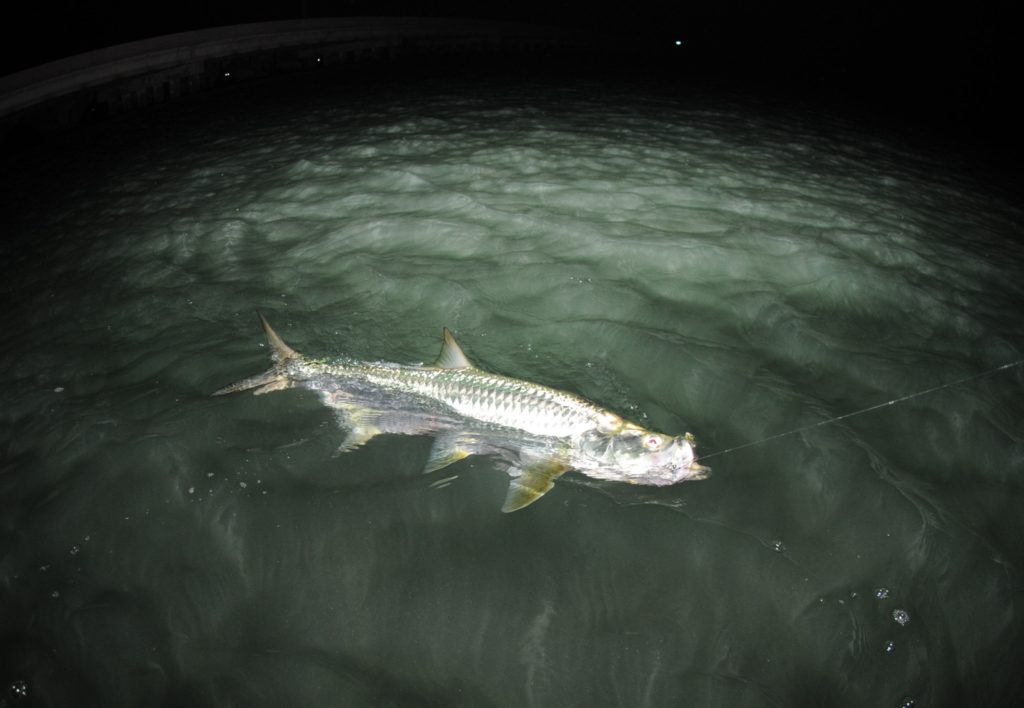
To get the interest of tarpon despite lots of small food items in the water, I cast slightly ahead and across a tarpon’s path, then begin a one-two twitch-and-pause movement to create an erratic serpentine dance in the soft bait. If the fish has any inclination to feed, it will jump on the bait. Fishing these lures on circle hooks offers an excellent hookup and landing ratio. On the strike, keep your rod tip low to the water as the line comes tight to the fish
THE MOMENT A HOOK POINT TOUCHES A TARPON’S JAW, IT WILL ROCKET AWAY.
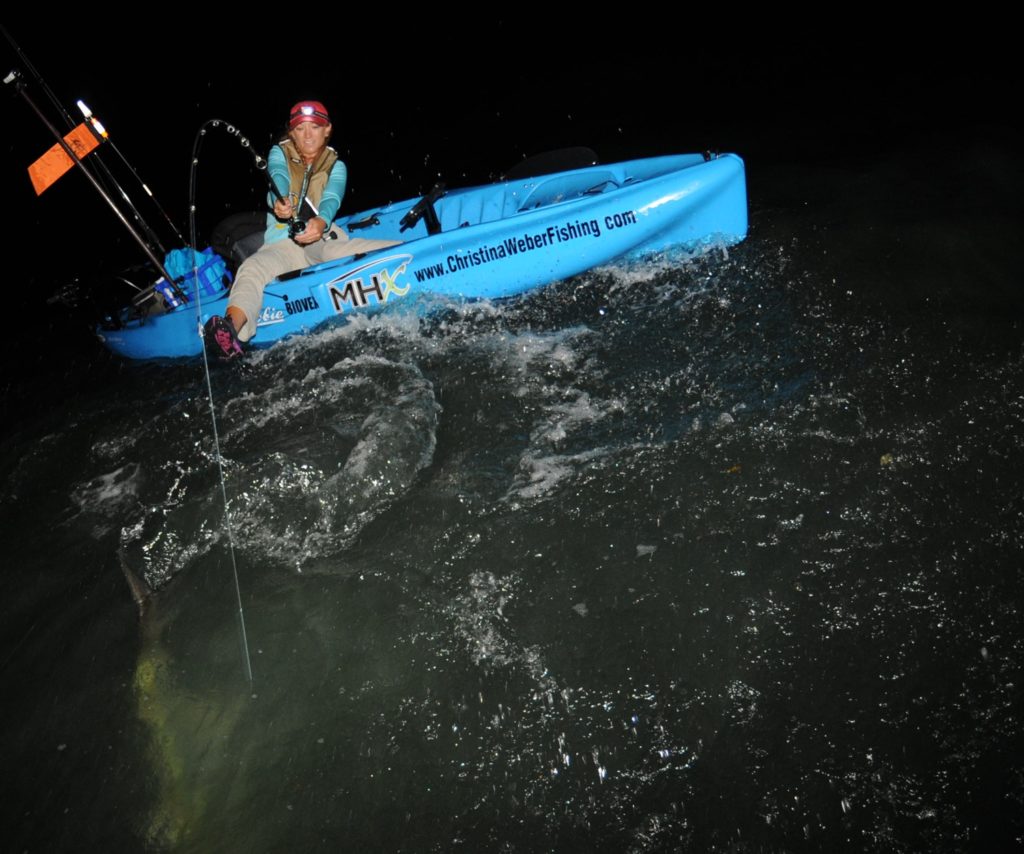
The moment a hook point touches a tarpon’s jaw, it will rocket away and upward from the pressure. It’s absolutely crucial to keep a tight drag during the hook-set. If the hook’s barb is unable to penetrate the bony mouth due to a slipping drag, you are guaranteed to lose the fish during its first series of jumps.

Traditionally, bridge anglers throw large swimming plugs like the Bomber Long A and Yo-Zuri Crystal Minnow to these slack-tide fish. The same slow and low twitching technique draws rod-jarring strikes. For tarpon, however, one negative to this type of bait is having to unhook unruly fish with a mouthful of sharp treble-hook points, which can be very difficult and downright dangerous. More and more big-game anglers are swapping out trebles with large single J hooks.
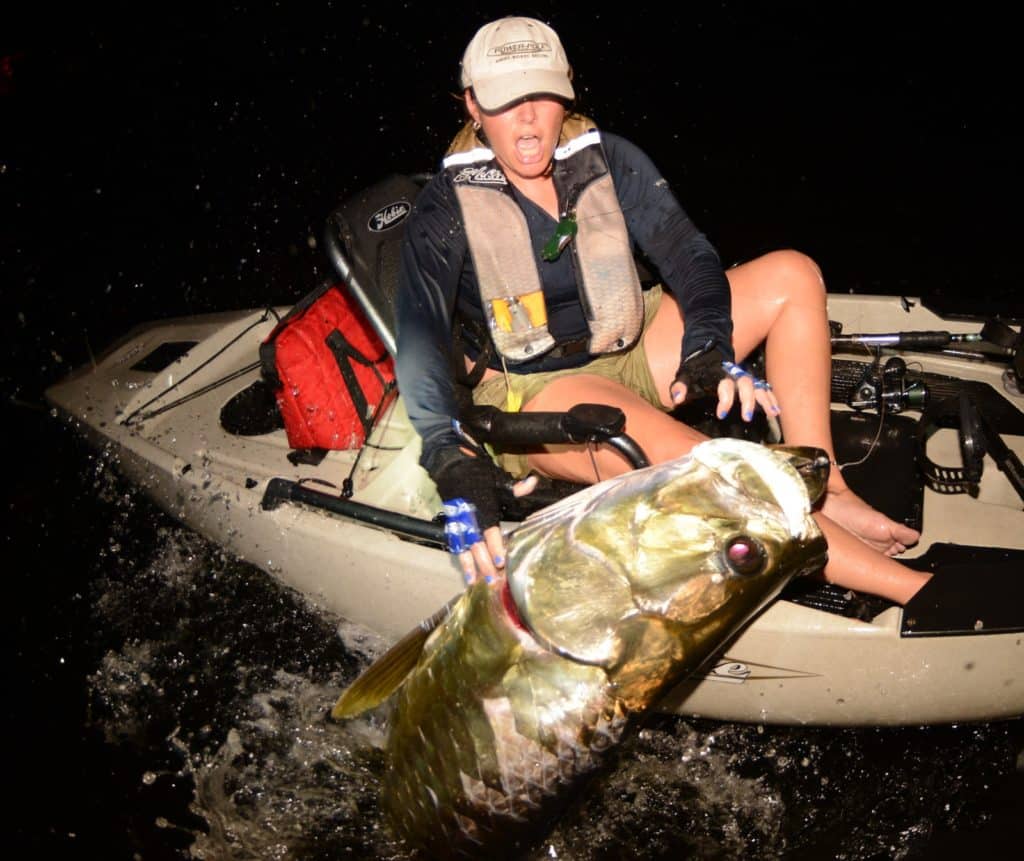
I’ve learned to be cautious during the end game. Being connected and in very close proximity to a fish well over 100 pounds requires quick thinking and a nimble balance. Handling these fish is difficult whether in a skiff or kayak. I use AFTCO’s Short Pump fishing gloves to keep my hands from being torn up by tarpons’ highly abrasive mouths.
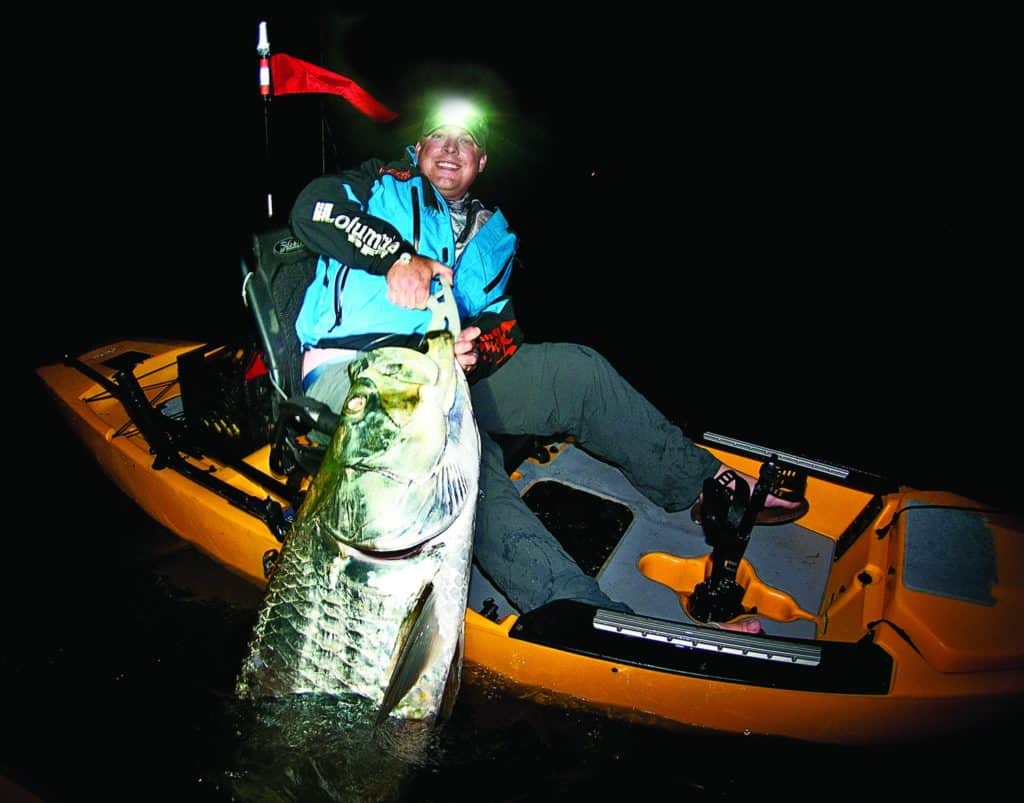
If you happen to be fishing from a kayak, unhooking the fish requires that a majority of your body weight hang over the same side of the kayak as the fish. My Hobie Pro Angler 14 offers a stable platform to safely handle these fish boatside. Short-handled dehooking devices can assist anglers in any sort of fishing kayak.
Towing a tarpon by hand to revive it can be sketchy: These waters teem with monstrous hammerhead and bull sharks that arrive each season in pursuit of the migrating tarpon. While reviving these fish, it’s important to never tether yourself or your kayak to the fish. I use a firm grip of the fist to tow them into the current for a few minutes while they revive.
Fortunately, most fish are landed in less than 20 minutes and are still quite green while being unhooked. This allows for a quick and successful release of the silver king.

At various times during the tarpon season in Southwest Florida, several species of prized game fish make an appearance to feed along coastal bridges’ nightly bounty.

Depending on the season, it’s not uncommon to hook into migrating cobia, over-slot (32-inch) snook and gag grouper. These species will fall for the same soft-bait jigging techniques used to entice the tarpon. And unlike tarpon, these game fish make for some great table fare.

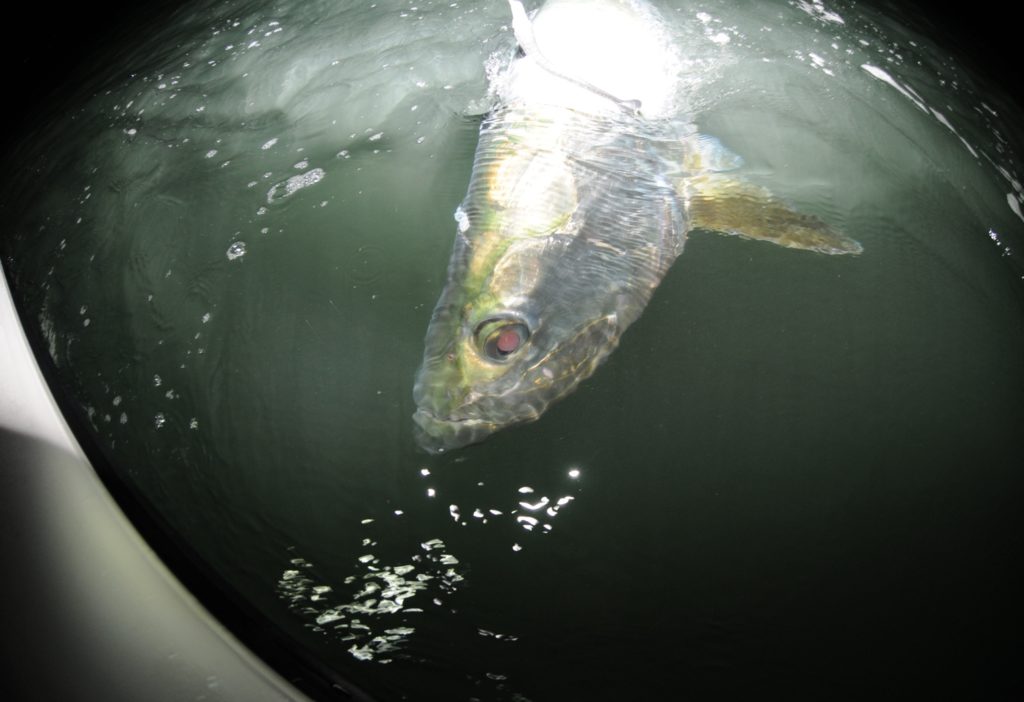
• Why: Most effective presentation during slick-calm conditions or for weary fish. Least noisy water entry — perfect for cruising fish on slack tide.
• How: Best when used with a slow twitch-and-pause retrieve in water less than 12 feet deep.
• When: Excellent when larger ballyhoo, needlefish and ladyfish are present.
• Lure: Hogy 10-inch Original Series (in black or bone colors).
• Hook: VMC 6/0 circle hook attached via stainless bait-keeper screw.
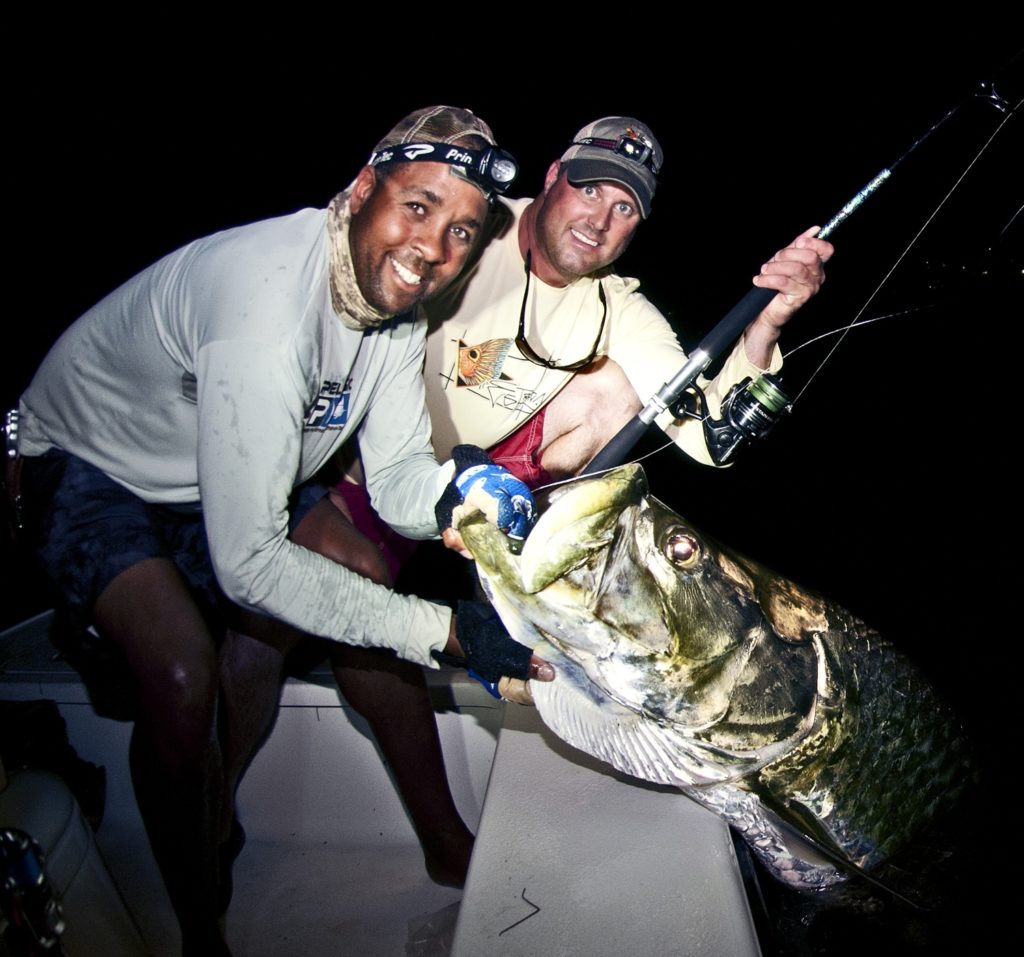
• Why: High-speed surface retrieves when tarpon are feeding aggressively on small baits. Quick way to cover ground while searching for actively feeding fish.
• How: Simple, fast, nontwitching retrieve is great for deep and shallow water.
• When: Very effective in choppy conditions.
• Lure: Hogy 7-inch HDUV Silver Tail.
• Hook: Barbarian 1-ounce 10/0 jig head.
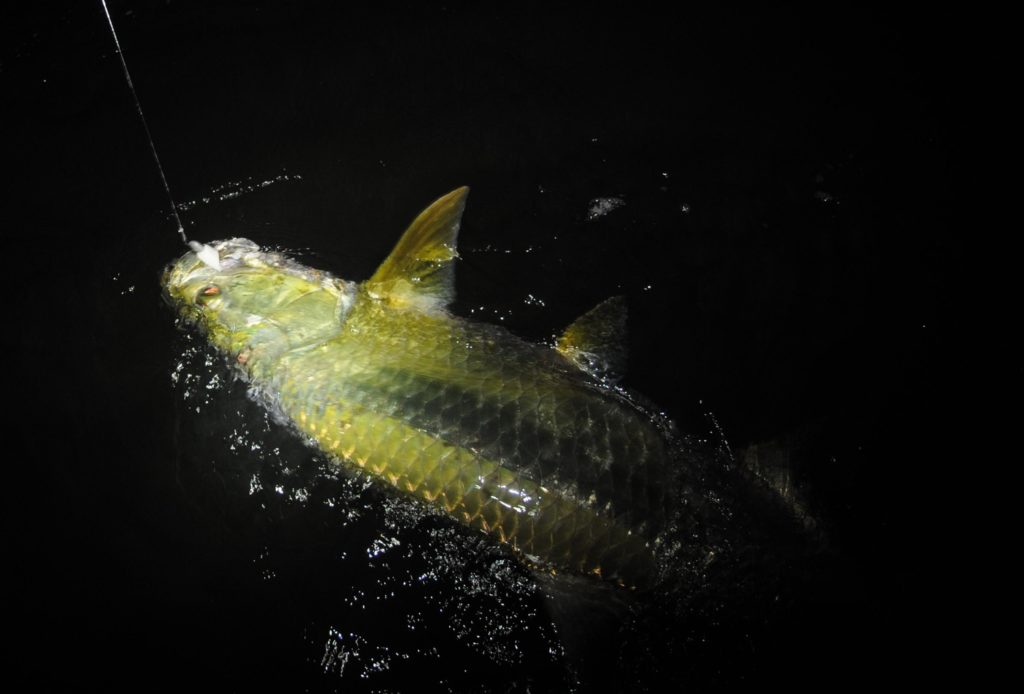
• Why: Very effective for targeting fish that have moved deeper in the water column. Excellent for deepwater channels and bridges in more than 12 feet of water.
• How: Traditional twitch-twitch, momentary pause retrieve.
• When: Ideal when fish are holding deep during the strongest portion of tidal phases.
• Lure: Hogy 9-inch HDUV black/purple flake tail.
• Hook: Barbarian 2-ounce 10/0 jig head.








